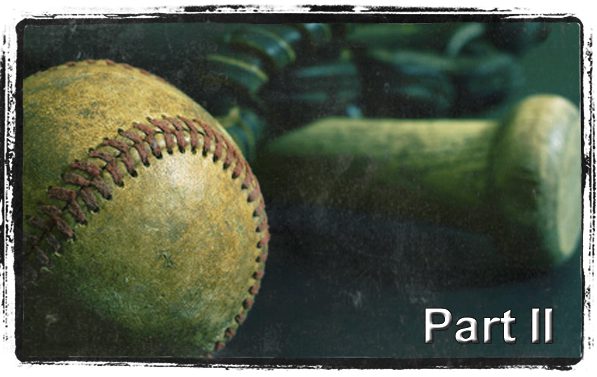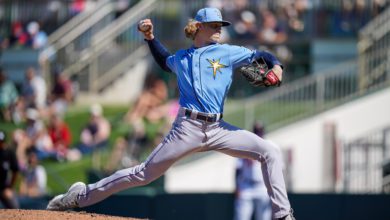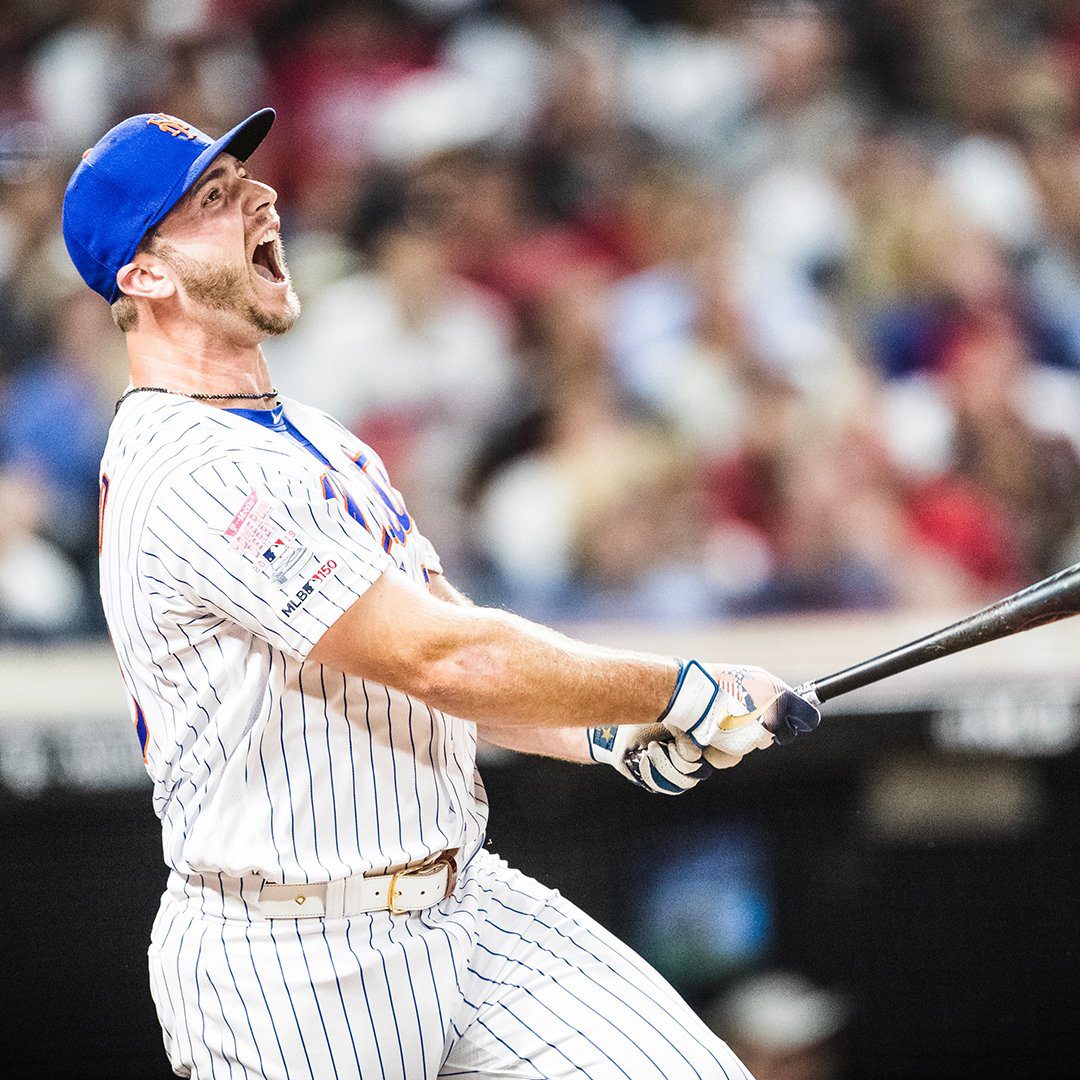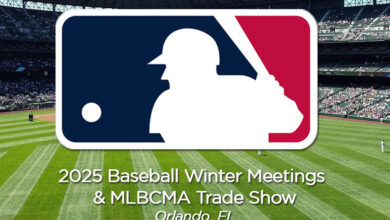
 Editor’s Note: Part II of a three-part series, where author Mark Moran takes us on a nostalgic journey back to his childhood baseball days. You’ll be hard-pressed not to relive your childhood if you’re 40 years old or older and you played youth baseball. Outstanding stuff. Read Part I and Part III.
Editor’s Note: Part II of a three-part series, where author Mark Moran takes us on a nostalgic journey back to his childhood baseball days. You’ll be hard-pressed not to relive your childhood if you’re 40 years old or older and you played youth baseball. Outstanding stuff. Read Part I and Part III.
Fffffffftt-thunk. Fffffffftt-thunk. Fffffffftt-thunk.
Ray Miles was throwing peas at the knees all night long. Past the batters and into my catcher’s mitt. It was a warm summer night at Long’s Field in Framingham, Mass. Under the lights. Against some team from Sherborn. Toward the end of our regular season, our coach, “Brando” Brandolini, had set up this exhibition for us. Probably to show off Ray. Maybe Sherborn should have been playing the Steve O’Neill Seals or the Jerry (Rico) Particelli Colts. But, tonight, they were playing us — the 2–7 Yankees. Sherborn might not be facing the best team in the league. But (surprise!), they were facing the best pitcher in the league.
Ray had a superior fastball, but what set him apart from the other kids with great fastballs was his unbelievable control. No wild pitches for me to chase to the backstop. His called strikes were right at the knees. And his balls just missed.
Long Field had three baseball fields — two Little League fields and one Senior League field. One of the smaller fields had a fence around the outfield that helped make it the gem of the league. Long’s had a basketball court under the lights, where, later in the 1970s, Mike McKeown and Richard Bowman and Rufus Harris would play their summer league games. Long’s was also the site of Loring Arena, a skating and hockey arena named after one of Dickie Loring’s relatives. We played Sherborn at the field without the fence — the one over by the arena.
When he pitched, we were a good team, not an average team or a pretty good team. A good team. When someone else pitched, we were a bad team. Simple as that.
Ray
Ray was a mid-season pick-up by Brando, the “before-his-time” manager and general manager. That summer, Ray had moved to Framingham from who-knows-where. He was the cousin (or maybe second-cousin) of Dickie Miles, who lived up off of Beaver Street somewhere, near Mark Bugden and Dean Agostinelli and George Griffin. And Brando, somehow (in a smoky room after midnight?) pounced on the athletic 12-year-old.
Ray wasn’t real big or tall or physically imposing. He was about the same size as me, with an athletic build and a tanned, handsome face. But, like Ron Guidry, he had those levers — the wrists, the fingers, the elbow and shoulder — that could make a baseball fly off his fingertips. And, he was cool and confident.
Before Ray moved in to town, my Yankees were 0–6, surely on our way to 0–10. Some games, we’d get an early lead … and a ray of hope. But, at the first sign of trouble — a fielding error that let in two runs, or our pitcher walking three batters in a row (not unusual) — we’d crumble mentally. “Here we go again,” we’d all think. And there’d we go.
It’s a real low feeling when a losing team takes the field knowing it’s going to lose … again. Baseball became penance instead of play. Then Ray moved into the two-man rotation and became our savior.
What’s the two-man rotation?
Framingham Little League teams played two games a week, Monday and Wednesday or Tuesday and Thursday. To protect the kids’ young arms, there was a rule that gave each pitcher a weekly innings-pitched ceiling of six innings (one full game). Most teams had one good pitcher and one okay pitcher. So, the strategy was this: The good pitcher starts the first game of the week. If he’s leading in a blowout or losing in a blowout, you take him out of the game after, say, four innings, and bring in a relief pitcher (the third best pitcher on the team) to mop up. This way, the number one pitcher could still pitch two more relief innings in the game later in the week.
From mid-season on, Ray pitched (and won) every other game we played. When he pitched, we were a good team, not an average team or a pretty good team. A good team. When someone else pitched, we were a bad team. Simple as that.
Fffffffftt-thunk. Fffffffftt-thunk. Fffffffftt-thunk.
As Ray piled up the strikeouts and the game against Sherborn wore on, it started to feel like a playoff game instead of an exhibition game. The drama grew and so did the crowd. Kids and adults came over from the basketball court and from the other baseball games at Long’s.
“Brando”
Our coach’s first name may have been Michael or John or Patrick (well, probably not Patrick). But I never heard anyone use it. Because everyone called him “Brando.”
“Hey, Brando!” the umpire would yell. “You got your lineup?”
Brando, apparently, liked his nickname because he had vanity license plates on his car that said, yes, “Brando.” And, in 1970, cars had two license plates — one on the back and one on the front (remember?).
So he thought he was cool, kind of like Matty Kulkin’s father, but I could tell he was really kinda corny. He was tall and gangly, not a natural athlete — that was evident from the way he hit grounders for infield practice. And, no, he wasn’t the best coach in the league.

He did, though, teach me one thing about catching. He said to be careful to make a good throw when throwing the ball back to the pitcher. Same thing Robert DeNiro’s character was told in Bang the Drum Slowly.
Brando owned and ran the shoe repair shop in downtown Framingham. (Note to Generations X and Y: Can you imagine taking your shoes to a shop to get them repaired?) His shoe shop was about as big as a shoe box, on a side street off Concord Street … Howard Street, I think, on the way to Sportswear. I’d been there. Dozens of pairs of old shoes sat neatly on old wooden shelves. Other pairs and singles were scattered all around the floor of the shop. Half-empty cans of shoe polish were strewn about. And the shop had a couple of those weird little benches used in shoe stores, which salesman would sit on to measure the size of kids’ feet with one of those metal foot-sizers.
But, on weeknights during the summer, Brando would lock up his storefront and head to Long Field or Butterworth Park or Anna Murphy … and coach a kids’ baseball team. And he drove a jet-black Monte Carlo with those license plates. (Brando is so memorable that Doug Tracia claims Brando was his Little League coach. But one guy couldn’t have coached two teams in the same league, could he?)
More important than all that, Brando saved my baseball life.
Kicking around the Bantam League
Until I was rescued by Brando, I had never played a single game in the Little League. At age 12, I was trying out for one of the green teams, maybe the Marlins or the Colts. This was my last chance to make Little League.
What’s the big deal about Little League? Well, for one, you had to make the team. Otherwise, you’d be sent down to the Bantam League (the Little League’s minor league). Another reason is the kids in Little League had uniforms. Chris Gorman’s Marlins had green ones. Doug’s Giants had brown ones. The Seals had blue, the Colts green. Next, my schoolmates, like Wayne Wales and Paul Ahern, had been playing in the Little League for a couple of years already. Finally, my little brother, Jim (better known as Rig), was on the verge of making a Little League team. It would have been the ultimate humiliation if my 10-year-old brother made a uniform team while I, with four chances, failed.
The summer before, when I was 11, I had played in the Bantam League for the Yankees-Indians. In order to form one team, the Bantam League teams needed castoffs from two Little League teams. So, the Yankees-Indians included kids, like me, who were cut from the Indians. And kids who were cut from the Yankees. The Bantam League also included the Royals-Orioles and several other two-name teams.
When I was 11, I played on the Yankees-Indians because I was cut from the Indians. There was no disgrace to be cut when you were nine or 10 — that was expected. Only the real good players, like O’Neill and Richie Terasconi and Chuckie Upham — made Little League when they were that young. But, to get cut at age 11 was pretty bad. I wasn’t bad. I was a good-fielding, light-hitting catcher who had a great tryout but got cut anyway because Bobby Slattery made the team instead. Why? Because Slattery’s father was the Indians coach.
I was comfortable, confident, engaged in the game, and having the most fun. Maybe it had to do with the anonymity of the mask and the chest protector and the shin guards. Anyway, catching made me feel special — especially on those four or five nights I caught Ray.
I’m happy to concede that “Slats” was a better football player than me. He proved that our junior year in high school when, playing for Framingham South High against cross-town rival Framingham North, he played the game of his linebacker life, making about 100 tackles. His inspired game impressed not only South High Coach Bob Jackiewicz, but also Bobby’s girlfriend, Marlene McDermott, and my girlfriend, Debbie Montalbano, who were both Pom-Pom Girls for North.
But in baseball, objectively, he really wasn’t close to me.
So, instead of playing on the Indians, I was “sent down” to the Yankees-Indians. Peter Lentz was on the Yankees-Indians. I think he was 11, too. I remember thinking, “How can anybody hit as good as Peter Lentz?” (That lasted until I played on the Senior League Angels with Bobby Verdolino and Chuckie Upham.) That season, Lentz and I each made the all-star team while hitting a handful of homers. Some were long fly balls over the left fielder’s head. But others were “ground-ball home runs,” hard shots that went in between the infielders and the outfielders and just kept rolling as Peter or I touched all the bases at Oakvale Field, an odd-shaped field with a short right field and an endless left field.
Squatting behind home plate
Anyone who’s played the outfield knows it can get pretty boring out there. That’s why I liked catching so much — it was anything but boring. I was in on every pitch. To pitch or play shortstop, you had to be really good. But the catcher just had to squat and catch the ball. Be willing to get nicked by foul balls. Chase wild pitches and passed balls back to the backstop. And try to throw out base-stealers.
In Little League, there was no leading. And, the runner couldn’t leave the base to steal until the ball was past the batter, which means that it must be in the catcher’s glove. Still, when it came to stealing, the runner had the advantage over the defense. Because in order to throw out a baserunner, five things had to go right. First, it had to be a good pitch. A wild pitch or a pitch in the dirt ensured the stolen base. Second, the catcher had to catch the pitch (no sure thing). Third, he had to make a good throw. Next, the infielder had to catch the throw. And make the tag. And not drop the ball (that’s six things). The runner just has to run fast and maybe slide. Still, Little League catchers managed to throw out a runner occasionally, maybe one out of five.

It was behind that white rubber pentagon — not batting or running the bases or playing any other position — where I was most at home in organized baseball. I was comfortable, confident, engaged in the game, and having the most fun. Maybe it had to do with the anonymity of the mask and the chest protector and the shin guards. Anyway, catching made me feel special — especially on those four or five nights I caught Ray.
And that year Brando’s Yankees needed a catcher. And they had room for one more 12-year-old. So, when I was about to get cut by that green team, Brando “picked me up on waivers” and made me his starting catcher.
Fffffffftt-thunk. Fffffffftt-thunk. Fffffffftt-thunk.
“Strike three!” the umpire bellowed. About once an inning, one of the Sherborn batters managed a weak grounder or pop-up that woke up a Yankee infielder. But, 11 or 12 of their 18 outs were Ks. At the same time, my Yankees managed to score a few runs. Ray probably knocked in two. Me? I didn’t hit much in Little League.
In fact, I hit exactly one home run for the Yankees. It was at Anna Murphy Field, up on Cove Ave. It went to dead center, over the outfielder’s head. As I sprinted for second, I entered foreign territory. No, I didn’t hit many doubles either. The ball was still way out there, so I went for third. A triple? That would be grand. Then, as I got close to third base, the third base coach waived me on to home. A home run? Me? Surely I’ll be thrown out and spoil the whole thing. Doubtful but obedient, I raced for home while my heart beat through my chest. Surprise and joy greeted me at home, as my sneaker touched the plate and the throw home whizzed toward the backstop. (Like the stealing thing, a clean relay play from the outfield to the plate was also unusual.)
The next day, the Framingham News said, “Mark Moran poled a long home run for the losers.” I was delighted, of course, that the word “long” described my only Little League homer. But poled? What the heck did that mean? I hit it with a pole? It was a 30-inch Louisville Slugger.
So, yes, I kind of know what it feels like to hit a home run. But, I always wished I’d hit one over that fence at Long’s — so I could say I know what a home-run trot feels like.
Age matters
In Little League, there were slots for five 12-year olds, five 11-year-olds, and a few nine- and 10-year-olds. And, it’s interesting to note the cutoff date for the age groups. The Rubicon was June 1. However old you were on June 1 determined which age slot you were in for that summer season. Mike (O.J.) Ohanesian, who grew up two doors down from Doug Tracia on Fountain Street, was born on June 2 — the best possible day of the year for baseball age categories. O.J. and I later played together on the Senior League Angels. He was born on June 2, 1958; I was born on April 1, 1958. We were in the same grade in school. But, as far as the Angels were concerned, I was 14 when he was 13. And, I was 15 when he was 14.
For me, those four wins helped convince my 12-year-old, self-doubting mind to keep playing, to try out for Senior League the next summer. And that’s the thing, isn’t it? Yup, that’s the thing — to keep on playing.
My younger brother, Rig, had a relatively advantageous baseball birth date. He was born August 13, 1959—16 and a half months after me. But, in Little League baseball terms, he was considered a full two years behind me. This looked like a problem for him, but it turned out to be a problem for my mother.
You see, I started played organized baseball (not Little League), when I was eight years old. The next year, of course, about-one-year younger brother figured: “I’m a year younger than Mark, he played last year; I’ll play this year.” But, that June 1 thing stood in the way. He would have to wait … another whole year! A year is a long time for a kid to wait to play baseball. Two years? An eternity. So my mother lied about Rig’s age. And he played in the eight-year-old Peanut League when he was only seven.
The following year, at a true age eight, he was the only returning player in the league. Everyone else in the league from the year before, of course, had not lied about their age, and had moved on to Midget League or Bantam League. So, what happened? My little brother, who was pretty good anyway (better than all his brothers) and had that year of experience that nobody else had, enjoyed the baseball summer of his life. He dominated the league with three-hit games and a handful of shutouts. One of those nights he pitched, I clearly remember standing down the left field line with my father, watching Rig finish off a no-hitter. After the last out, his teammates mobbed him on the mound, just like the World Series.
Rig made the Cubs at age 10, the same year I made the Yankees at age 12. He fit right in to their hard-hitting lineup that included Chuckie Upham and the Van Heest brothers, Doug and Dave. And, he had a successful three-year career with them.
To this day, Rig says that he and I are the only brothers in the history of the Framingham Little League to not play on the same team. I have no explanation for that.
Finishing off Sherborn
Ray shut down those out-of-towners, but good. The final score was, probably, 4-1 or 4-0. But because of Ray, the outcome was never in doubt.
For dramatic effect, Ray, of course, struck out Sherborn’s last batter. And I had the game ball right there in my catcher’s mitt. I took off my face mask and felt like I had cashed in a get-out-of-jail-free card. Here it was — that thrill of victory they talked about on Wide World of Sports. Ray Miles was the winning pitcher. I was the winning catcher. And, Brando was the winning manager. Win-win-win. What a difference from the first half of the season.
It was only one game. But the result seemed to say: The kids from Sherborn may be smarter than us … or richer … but the Framingham kids are better baseball players. Period. Even trade? Nah … We came out way ahead.
So, outside of traditional tryouts — which may have left the Yankees with zero wins — our shoe store manager picked up an ace pitcher and a pretty good defensive catcher who turned out to be a complement to the ace pitcher. And he scheduled that glorious exhibition game against Sherborn.
So we ended up 3-7. Not great but a long way away from 0-10. Plus that win against Sherborn. What’s the difference between 3-7 and 0-10? When you’re 10 or 11 or 12 years old, a lifetime. No, an eternity. One trip around planet earth, maybe … no, a light year.
For me, those four wins helped convince my 12-year-old, self-doubting mind to keep playing, to try out for Senior League the next summer. And that’s the thing, isn’t it? Yup, that’s the thing — to keep on playing.
Up next: Part III — Senior Little League





